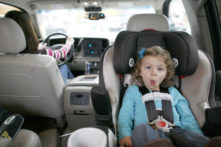Articles in the last issue of SRN (July/August 2017) covered the major CPS news story that a key, real-life study on the benefits of riding rear facing up to age 2 had been discredited and the status of updated research that will potentially replace it. Since the journal Injury Prevention issued an Expression of Concern about the 2007 Henary, et al, study—essentially voiding its validity—the CPS community has eagerly awaited a valid study that will replace it in order to guide future policy.
At press time, at least two studies have been completed to reanalyze this data. Neither, however, has completed the peer-review and publication process that is necessary before any scientific research can be relied upon. Therefore, this is an ongoing and evolving situation; this article aims to summarize new developments since the last SRN issue went to press in late August.
Word From Policymakers
In September, NHTSA issued a statement that was shared both internally and with outside organizations, such as the Juvenile Products Manufacturers Association, reaffirming its current best-practice CR selection guidelines, which include that children should ride rear facing as long as possible.
The American Academy of Pediatrics (AAP) is another community leader that issues policy on CPS topics. Since the AAP’s 2011 policy statement, “Child Passenger Safety,” is still current policy, it should continue to be followed as best practice. The AAP routinely reviews all policy statements and either reaffirms or updates them, so some news from the AAP on its CPS statement should be expected in the coming months.
Status of Research
As of press time, the CPS community is still awaiting the publication of at least one of the two studies that have been conducted that would essentially replace the 2007 Henary research. The journal Injury Prevention has stated it will publish the University of Virginia (UVA) study once peer review is completed. Sources indicate that this is imminent.
The last issue of SRN indicated that the JP Research, Inc., study, which Dorel first commissioned for use in a lawsuit defense, would go through some form of peer review prior to being presented at the Stapp Crash Conference in November. However, SRN has now learned that the result of that review is that the research will not be presented at the conference after all. Jeya Padmanaban of JP Research, Inc., says she plans to submit the research to Injury Prevention.
As described in the last issue, it is not appropriate to share details of research that has not completed the peer review needed for publication. However, from what has already been shared or implied, although both the UVA researchers and JP Research agree that the 2007 Henary study was faulty, it seems likely that the updated studies (of the same data) that each has produced will not be in sync with each other. Therefore, the decision of the scientific community regarding which of these studies warrants publication will be significant.
CPS Community Meeting
On September 1, a large group of technicians met for a special-session panel discussion on this topic during the Kidz in Motion Conference in Colorado. Joe Colella, of Traffic Safety Projects, served as moderator, and pediatrician Dr. Ben Hoffman spoke from the perspective of the medical community, while Dorel’s Terry Emerson gave a CR manufacturer’s view. The moderator and panelists provided a review of events, which largely mirrored what was covered in SRN’s last issue, and a question-and-answer session followed.
As an Oregonian, Dr. Hoffman was able to add the perspective of someone who worked over the past year to promote the passage of an update to the state’s child occupant protection law, which now requires children to stay rear facing until age 2. Dr. Hoffman said that the timing of these recent revelations, so shortly after the passage of the new law, was certainly not ideal. However, he updated the Oregon lawmakers who’d backed the bill and assured them that current best-practice guidelines are unchanged.
Terry Emerson spoke for Dorel regarding the sled-test research that Dorel conducted to follow up the JP Research, Inc., statistical analysis it had commissioned, as described in SRN’s last issue. As Emerson reiterated, what Dorel wanted to do was explore whether CR/child interaction with the vehicle front seat might be something that current testing using the NHTSA test seat fails to capture. Using the test apparatus developed by Consumer Reports, Dorel felt that that this was a hypothesis worthy of more exploration, but so far testing has been very limited in scope.
None of the researchers directly involved with any of the past or current studies on this topic were available to participate in the session. However, had any been in attendance, their ability to add to the discussion would have been severely limited, since, at that time, none of the newer studies had been properly vetted through peer review.
Therefore, although the session was a chance to make sure CPSTs in attendance were aware of the current situation and given the chance to air questions and concerns, the message remained that, despite the news, the field is essentially in a holding pattern. Current best-practice guidelines should be followed unless new information is provided by policymakers.

